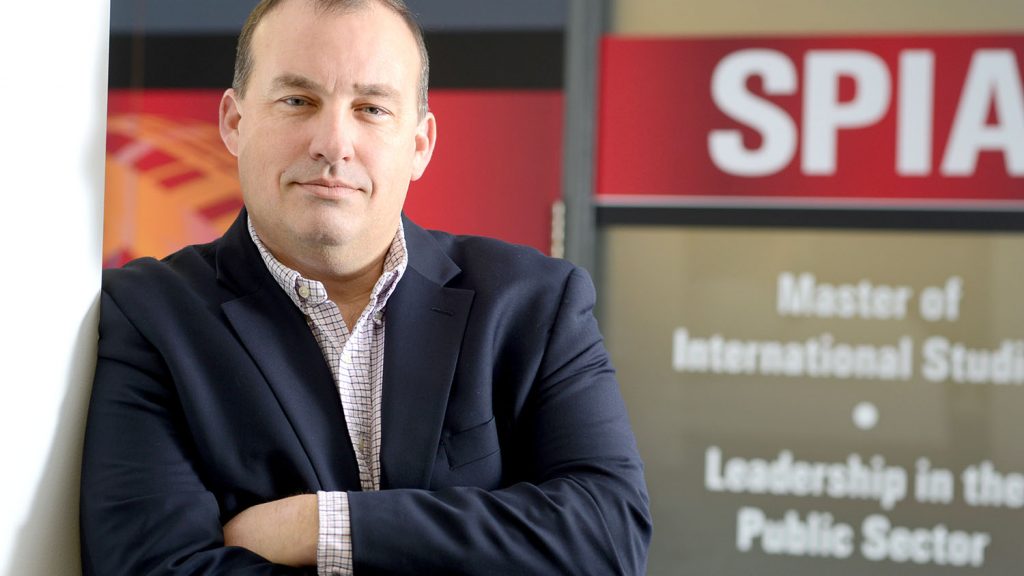Data Detectives Track Down Stray Nukes
The Consortium for Nonproliferation Enabling Capabilities aims to enhance the capabilities of the nonproliferation community.

- First data point: A contractor places an order for lumber, dry wall, wiring, cement, paint — all the materials you would need to build an unremarkable warehouse.
- Second data point: A thousand miles away, a shipment of magnetic high-speed bearings is stolen from a freight truck.
- Third data point: An oil-exploration company discovers that one of the radiological sources it uses in sensors that gather geological data from boreholes has gone missing.
- Fourth data point: Mobile radiation detectors in a midsize city find traces of radiation higher than the normal background radiation would account for.
Then a data analyst uses a computer in a secure facility, as well as some highly sophisticated data-analysis techniques, to connect these four dots as signs of illegal nuclear proliferation activities. In short, somebody’s probably trying to build a dirty bomb — but now we’re onto them.
That kind of early detection is the goal of the Consortium for Nonproliferation Enabling Capabilities, a partnership funded by the National Nuclear Security Administration and led by NC State. CNEC’s partners comprise seven universities and four national laboratories, all collaborating to stop the illegal proliferation of nuclear weapons.
CNEC’s main mission is embodied in its name: The consortium aims to enhance the capabilities of the nonproliferation community, says Yousry Azmy, Distinguished Professor of Nuclear Engineering at NC State and director of CNEC.
“We are not necessarily providing gadgets needed in the field today, but we’re providing capabilities — human resources, theories, analytical techniques — to enable the solution of problems we can’t solve with today’s gadgets,” Azmy explains. “A technical breakthrough typically starts with a foundational shift or discovery that makes people realize they could do what they thought they couldn’t do. Once that capability exists, you build implementations on it.”
“We are not necessarily providing gadgets needed in the field today, but we’re providing capabilities.”
CNEC is led by NC State faculty members, from left, Yousry Azmy, the consortium’s director; Robin Gardner, its chief scientist and John Mattingly, its technical director.
Most of CNEC’s work is divided into four thrust areas:
1. Signatures and observables focuses on detecting proliferation activities by their externally observable characteristics.
“When proliferation activities occur, many things happen: people buy food for support staff, they buy materials to build facilities, they obtain specialized equipment, they get their hands on radiological sources or special nuclear material,” Azmy says. “All of these things may be mixed up with a whole bunch of other data that you have access to. You want to be able to pull out of that data a ‘signature’ that says, ‘this entity in this country is doing something that would amount to a potential proliferation risk.’ You have to be able to draw deeper conclusions than the surface appearance might suggest, to puzzle out a relationship that is not evident.”

Research in this thrust area is led by Clair Sullivan at the University of Illinois at Urbana-Champaign, and involves John Mattingly, associate professor of nuclear engineering at NC State, who is co-principal investigator and technical director of CNEC.
2. Simulation, analysis and modeling develops tools that allow scientists to better simulate the dispersion of radiation from its point of origin to the point where it’s measured, especially as the radiological source is being transported or hidden during covert proliferation activities.
“Say there’s a radiation source hidden in an urban environment,” Azmy says. “You want to drive around with detectors to try to find it, so you need to be able to measure the radiation field; but you also need to create models that allow you to supplement your measurements and enhance the viability of your assumptions. These models require understanding how the radiation moves from where it’s emitted to where you observe it. Because of the different types of radiation you encounter and the different materials the radiation moves through, it’s a very complex problem.”
These models require understanding how the radiation moves from where it’s emitted to where you observe it.
The desire to solve that complex problem is what drives the work of Dylan Hoagland, a Ph.D. student in nuclear engineering at NC State and a CNEC Fellow. Hoagland’s doctoral research — improving the computational models showing how neutrons travel from radiological sources — is situated squarely in the simulation, analysis and modeling thrust area.
“I remember when I was a kid watching that PBS show Nova, they were talking about string theory and quantum mechanics and all the implications of it, and I thought it was mind-blowing how you could extrapolate so much about reality just from doing math,” Hoagland recalls. Now he’s working on the fearsome math necessary to improve the efficiency of the massively parallel computer calculations needed to simulate the behavior of neutrons and photons emitted by radiological sources.
“In mathematics it’s called an ‘inverse problem,’” he explains. “Typically in math and science we work from cause to effect, but in radiological detection you start with the effect — the detected radiation — and work backward to figure out the cause. The problem, however, is that when you detect radiation, the source could be in any number of locations, giving you lots of potential causes. So we simulate many different hypothetical scenarios with the radiological source in lots of different locations, and we evaluate those scenarios to determine which one is most likely to be true. My research aims to develop methods for simulating these scenarios more quickly and efficiently.”

Having a robust simulation on hand could be useful in the case of nuclear materials concealed in a large, complex facility, such as a dirty bomb hidden in a sports stadium, Hoagland says.
“The more robust your computational model is, the quicker you can find that nuclear material,” he says. As part of his CNEC fellowship, Hoagland will work an internship at Los Alamos National Laboratory this summer.
Much of CNEC’s research in this area involves improvements to radiation transport modeling, led by CNEC technical director John Mattingly.
This 3-D surface plot, generated by software programmed by CNEC Fellow Dylan Hoagland, shows a simulation of the distribution of neutrons emitted by radiological sources. The conical spikes in the surface plot represent the radiological sources.
3. Data fusion and analytical techniques leverages NC State’s leadership in big data to develop tools allowing analysts to extract useful information out of reams of data.
“‘Fusion,’ in this case, means the mixing of multiple streams of information and data into a single line of thought that then would produce information that is beneficial to the decision-maker,” Azmy explains. “It’s not usually a yes-or-no decision. It’s a nuanced stream of decisions because the things you need to monitor in order to catch proliferation activities could be very innocent on the surface; but when you add them all together, they become indicative of malicious objectives. So you put an enormous amount of data into computational machinery, and the data tells you something fishy is going on here.”
So you put an enormous amount of data into computational machinery, and the data tells you something fishy is going on here.
This thrust area is led by statistics professor Alyson Wilson, head of NC State’s Laboratory for Analytic Sciences, a partnership with the National Security Agency.
4. Replacement of dangerous radiological sources works to help industry users of radioisotopes come up with safer methods to achieve their business goals.
Since its discovery, radiation has been used in many benign applications: medical imaging and treatments, food irradiation, even oil exploration. There are three sources of radiation used this way: long-lived radioisotopes, short-lived radioisotopes and radiation generated by accelerators, as in an X-ray machine. Accelerator-generated radiation is the safest because it can’t be used in proliferation activities; it literally has an off switch. From a nonproliferation standpoint, it would be preferable if all industrial radiation could be generated by accelerators, but that isn’t possible for a variety of logistical and economic reasons.
The next-safest type of radiation is that generated by short-lived radioisotopes. These isotopes have half-lives lasting from mere minutes up to a few days. “If you have a radioisotope that has a half-life of one hour and you hold on to it for a whole day, it will basically have become too weak by the end of the day,” Azmy says. That characteristic makes short-lived radioisotopes unsuitable for proliferation activities — and a hard sell for many industrial users.
“Lots of people in industry prefer to use long-lived radioisotopes for obvious reasons,” Azmy says, “but those are the most dangerous. Imagine a company uses a radioisotope with a half-life of a few years. If a rogue entity steals that radioisotope and hides it for a week before using it in a dirty bomb, that material could still be very dangerous.”

We’re looking to produce the people who do the work of nonproliferation.
This thrust area of CNEC works on research that will help industry users of long-lived radioisotopes switch to either short-lived radioisotopes or accelerator-generated radiation, meaning there will be fewer radiological sources in the world for would-be proliferators to acquire. This area is led by Bill Dun at Kansas State University, and involves Robin Gardner, Alumni Distinguished Graduate Professor of Nuclear Engineering at NC State, who is principal investigator and chief scientist of CNEC.
Beyond the four main thrust areas, CNEC also does crucial work in training the next generation of experts in nuclear security policy. One of the leaders of that effort is Bill Boettcher, associate professor of political science at NC State. Boettcher is a nuclear security and nonproliferation policy expert whose work with CNEC focuses on curriculum development and teaching.
Bill Boettcher, associate professor of political science at NC State, worked with his colleagues in CNEC to create and launch a graduate certificate in nuclear nonproliferation science and policy in spring 2017.
“We’re looking to produce the people who do the work of nonproliferation,” Boettcher says. “We want to turn out nuclear engineers who know enough about policy to do nonproliferation work in the national labs or at the Department of Energy. We also want to develop policy students who know enough about the technology involved that they can be conversant as they work in the State Department or elsewhere in the policy community.”
The NNSA has recognized that people in the nuclear security and nonproliferation field have a “haphazard but eventually interdisciplinary” approach to their topics — and a lot of those people are retiring, Boettcher explains. The agency wants CNEC to train the next generation of professionals in the field to be interdisciplinary by design. To that end, Boettcher and his CNEC colleagues have created a brand-new graduate certificate in nuclear nonproliferation science and policy, which admitted its first students in the spring semester.
All of these aspects feed into a decision-making machine that someone is going to have to use to say, ‘this is a conclusion. This is what we need to do to combat nuclear proliferation.’
Education, detection, simulation, modeling, analysis — CNEC presses the nonproliferation fight on all these fronts because that’s what the challenge requires, Azmy says. “Nonproliferation is a broad problem,” he says. “That’s why these areas within the consortium don’t live in silos; we communicate across them. All of these aspects feed into a decision-making machine that someone is going to have to use to say, ‘this is a conclusion. This is what we need to do to combat nuclear proliferation.’”


